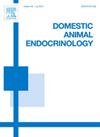超高效液相色谱-串联质谱法测定甲亢猫、健康猫和azotemic猫体内逆三碘甲状腺原氨酸浓度
IF 2.1
2区 农林科学
Q2 AGRICULTURE, DAIRY & ANIMAL SCIENCE
引用次数: 0
摘要
没有甲状腺显像,诊断猫甲状腺功能亢进可能是具有挑战性的。本研究的主要目的是使用超高效液相色谱-串联质谱(UPLC-MS/MS)定量甲状腺功能亢进猫、健康猫和azotemic猫的总3,3 ',5 ' -三碘甲状腺原氨酸(total reverse T3, TrT3)浓度,并研究其作为甲状腺功能亢进诊断预测标志物的潜力。假设在猫甲状腺机能亢进症中,代表T4“失活”代谢物的rT3相对于T4和“活性”T3增加。对138只接受放射性碘治疗的甲状腺功能亢进猫、73只健康猫和83只患有肾病的猫的剩余样本进行了分析。Azotemic猫被纳入,代表可能患有非甲状腺疾病综合征的猫。采用健康组计算参考值,并探讨年龄和性别的影响。UPLC-MS/MS检测两种T3异构体均具有较高的分析灵敏度。TrT3与总T4呈正相关(TT4, rSP = 0.937, P <;0.001),总T3浓度(TT3, rSP = 0.866, P <;0.001)。TT4与TT3呈正相关(rSP = 0.939, P <;0.001)。与其他组相比,甲亢猫的TT4、TT3和TrT3浓度以及TrT3/TT4比率更高(P <;0.001),而TT3/ trt3比值较低(P <;0.001)。85.5%的甲亢猫的TrT3浓度超过TT3。roc曲线分析确定甲状腺功能亢进的最佳临界值为TrT3和gt;0.75 nmol/l(灵敏度1,特异性0.968)。性别(P = 0.848)和年龄(P = 0.691)均无影响。综上所述,rT3是猫甲亢中含量第二丰富的甲状腺激素,可通过ulc -MS/MS检测,诊断准确率高,为研究猫碘甲状腺原氨酸代谢开辟了新的途径。本文章由计算机程序翻译,如有差异,请以英文原文为准。

Reverse triiodothyronine concentrations in hyperthyroid, healthy, and azotemic cats determined by ultra-performance liquid chromatography-tandem mass spectrometry
Without thyroid scintigraphy, diagnosing feline hyperthyroidism can be challenging. The primary aims of this study were the quantification of total 3,3′,5′-triiodothyronine (total reverse T3, TrT3) concentrations in hyperthyroid, healthy, and azotemic cats using ultra-performance liquid chromatography-tandem mass spectrometry (UPLC-MS/MS) and to investigate its potential as a predictive marker for the diagnosis of hyperthyroidism. The hypothesis was that in feline hyperthyroidism rT3, representing the “inactivated” metabolite of T4, increases in relation to T4 and “active” T3. Left over samples of 138 hyperthyroid cats submitted for radioiodine treatment, 73 healthy cats and 83 cats with kidney disease were analyzed. Azotemic cats were included to represent cats with possible non-thyroidal illness syndrome. The healthy group was used to calculate reference limits and to investigate the influence of age and gender. UPLC-MS/MS detected both T3 isomers with high analytic sensitivity. TrT3 measurements correlated positively with total T4 (TT4, rSP = 0.937, P < 0.001), and total T3 concentrations (TT3, rSP = 0.866, P < 0.001). TT4 correlated positively with TT3 (rSP = 0.939, P < 0.001). Hyperthyroid cats had higher TT4, TT3, and TrT3 concentrations as well as TrT3/TT4 ratios compared to the other groups (P < 0.001), whereas the TT3/TrT3-ratios was lower (P < 0.001). TrT3 exceeded TT3 concentrations in 85.5 % of the hyperthyroid cats. The optimum cutoff to identify hyperthyroidism determined by ROC-curve analysis was TrT3 > 0.75 nmol/l (sensitivity 1, specificity 0.968). No effects of gender (P = 0.848) or age (P = 0.691) were observed. In conclusion, rT3 is the second most abundant thyroid hormone in feline hyperthyroidism, can be measured by UPLC-MS/MS with high diagnostic accuracy and its measurement opens new doors to investigate feline iodothyronine metabolism.
求助全文
通过发布文献求助,成功后即可免费获取论文全文。
去求助
来源期刊

Domestic animal endocrinology
农林科学-奶制品与动物科学
CiteScore
5.50
自引率
4.80%
发文量
58
审稿时长
31 days
期刊介绍:
Domestic Animal Endocrinology publishes scientific papers dealing with the study of the endocrine physiology of domestic animal species. Those manuscripts utilizing other species as models for clinical or production problems associated with domestic animals are also welcome.
Topics covered include:
Classical and reproductive endocrinology-
Clinical and applied endocrinology-
Regulation of hormone secretion-
Hormone action-
Molecular biology-
Cytokines-
Growth factors
 求助内容:
求助内容: 应助结果提醒方式:
应助结果提醒方式:


